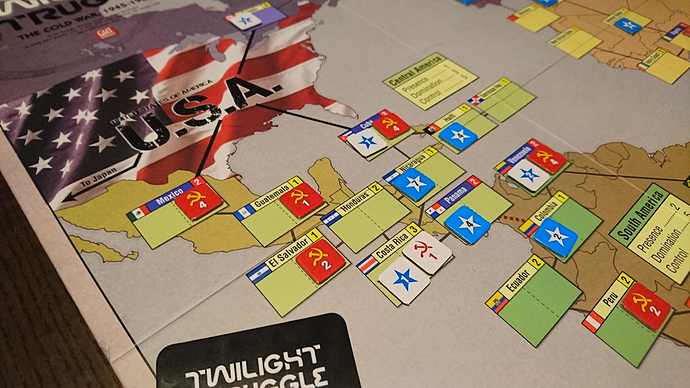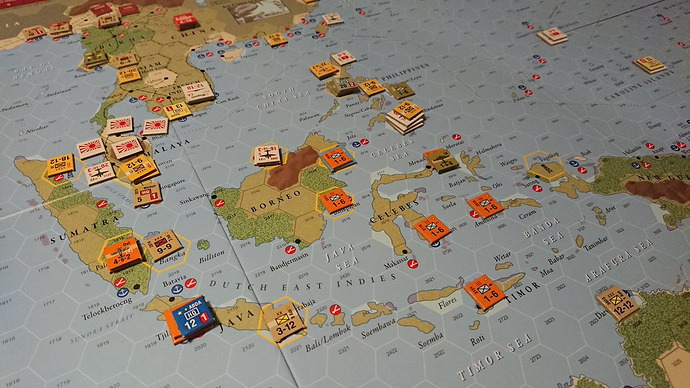I wanted to play Commands & Colors Ancients (19th play) last week, so Anthony and I played the Pyrrhic War scenarios from the Greek expansion on Monday and Wednesday. Pyrrhus’s army is the first time the Romans encountered war elephants, and in the Commands & Colors system elephants are fragile - they always seem to get themselves killed after the initial charge. I’m beginning to think it’s better to hold them in reserve and only send them in to mop up damaged units.
On Thursday we needed something appropriately spooky for Halloween so we went to Dan’s and proceeded with our Arkham LCG (30th play) Forgotten Age campaign. Seems the first scenario in this campaign was intentionally quite difficult, because we made it out of the second without having to add any extra trauma or weaknesses.
Anthony and I had time for a 2p while waiting for others to arrive on Friday, so we played a learning game of Watergate (3rd play). So far, Nixon has won every game of this I’ve played, since letting him get to 4 momentum feels safe - until he plays Gambit and wins immediately.
We split up after more people arrived - Anthony played Space Explorers and Irish Gauge at the other table while I played 1846 (28th play) with Sean and Matt. This was a really funny game, where I got O&I and Mail Contract, Sean got Michigan Southern, and Matt was stuck with a rather expensive collection of privates - Big 4, C&WI, and Tunnel Blasting. My plan was to par the IC high and get a good Mail Contract run on OR1.2, but Sean took the IC first. Perhaps the ‘best’ thing to do would be to take NYC but I assumed Matt might par it low and scoop up the 2 trains for me so I picked B&O instead. Matt decided to invest, but Sean started Grand Trunk as a second company in SR1 to help out IC in the north. We went into the first set of ORs with no NYC on the board, and things just got weirder from there. We called the game after OR3.2 because we bought up to the grey trains much quicker than Matt anticipated and he got stuck holding a single certificate and just one permanent train in his company.
Jayme & Chandler had just bought a copy of Point Salad (1st play) and we bravely played with 6 players. This is not a 6p game - 3 is the highest player count where you can control at least one card that will be available on your next turn. I’m probably overthinking it, but that’s my brand. 
Since we had 6 people at the table, I suggested Quartermaster General (21st play) and Anthony, always my wingman for these things, provided the momentum to get the game started. The original QMG is one of my absolute favorite games, and I’ve gotten used to just teaching it with everything - Air Marshal, Alternate Histories, and even Prelude. I’m still getting used to the way the game plays with France and China - the Allies actually start at a sprint, for as long as they can protect western Europe and China. That’s how this game began, until slowly, inevitably, France, China, and the eastern front all collapsed. The Pacific theater was starting to look dangerous for the Axis between the ANZAC force in the Philippines and the US navy in Iwo Jima, but the game ended in an Axis victory before we could take the shot at the Japanese home islands.
Saturday we went to an Extra Life extra life event, but didn’t actually play all that many games - there was a lot more general socializing and hanging-out. Anthony and I began with a rematch in Watergate (4th play) where the editor finally won by occasionally contesting Nixon on momentum. We also had time to play Traders of Osaka (16th play) while others were still in a game of Colosseum, and it was a tight competition until the end of a very high scoring game - I kept red out of the port for most of the game but a fortunate flip gave the game to Anthony, 36 - 24.
David and Jamie had arrived by the time the game of Colosseum ended, and I taught them how to play Age of Steam (2nd play). I needed a bit of a refresher myself, since it had been more than a year since I played it for the first time, but I did a reasonable job teaching. In this case, “reasonable job” means no one went bankrupt, and I didn’t win! I’ll be receiving my copy of AoS later this week, so I anticipate being able to get a few more 3p games in with expansion maps over the next month or so.
To close out the night, we had convinced Dan to come down and play games with us at the Extra Life event, and we continued the Arkham Horror LCG (31st play) campaign, and powered through one of the Unlock games we borrowed from Chandler. She said she was impressed by the way we work through escape room games, but I think at least some of that is because having three sets of eyes and hands is ‘ideal’ for most board game escape rooms. We finished Insert Coin in 27 minutes and only needed one hint… at the very, very beginning. 








